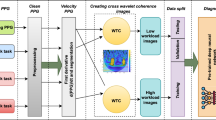Abstract
Accurate heart rate monitoring from motion-corrupted photoplethysmographic (PPG) signals is very challenging due to the unpredicted nature of motion artifacts contaminating in the recorded signal. By availing reference artifact signals, adaptive filtering can be applied to the noisy signal to get a cleansed PPG signal from which the heart rate can be estimated. Three-axis acceleration data can be used as the reference signal for adaptive filtering. Some of the earlier methods use sparse signal decomposition, signal reconstruction, and spectrum estimation methods to estimate the heart rate. Here instead, a method of the least mean square adaptive filtering with decomposed acceleration signals as reference signals and spectrum estimation using periodogram is proposed. Since the reference signals used for adaptive filtering are decomposed into singular components the convergence of adaptive filter will not be hampered. Signal sparsification and reconstruction were not used and the whole processing was done on the exact recorded signals which increases the robustness of the method. Also, the simplicity of nonparametric spectrum estimation method leverages the system.






Similar content being viewed by others
References
A. Kamal, et al., Skin photoplethysmography a review. Comput. Methods Prog. Biomed. 28(4), 257–269 (1989)
J. Allen, Photoplethysmography and its application in clinical physiological measurement. Physiol. Meas. 28(3), R1–R39 (2007)
T. Tamura, Y. Maeda, M. Sekine, M. Yoshida, Wearable photoplethysmographic sensors – past and present. Electronics. 3(2), 282–302 (2014)
Y. Maeda, M. Sekine, T. Tamura, Relationship between measurement site and motion artifacts in wearable reflected photoplethysmography. J. Med. Syst. 35(5), 969–976 (2011)
M. Ram, et al., A novel approach for motion artifact reduction in PPG signals based on AS-LMS adaptive filter. IEEE Trans. Instrum. Meas. 61(5), 1445–1457 (2012)
X. Sun, et al., Robust heart beat detection from photoplethysmography interlaced with motion artifacts based on empirical mode decomposition. in Proc. IEEE Int. Conf. Biomed. Health Informat., (2012), pp. 775–778
F. Peng, et al., Motion artifact removal from photoplethysmographic signals by combining temporally constrained independent component analysis and adaptive filter. Biomed. Eng. Online. 50(1), 13 (2014)
B. Lee, et al., Improved elimination of motion artifacts from a photoplethysmographic signal using a Kalman smoother with simultaneous accelerometry. Physiol. Meas. 31(12), 1585–1603 (2010)
R. Youse, et al., A motion-tolerant adaptive algorithm for wearable photoplethysmographic biosensors. IEEE J. Biomed. Health Informat. 18(2), 670–681 (2014)
S.M. Lopez, et al., Heuristic algorithm for photoplethysmographic heart rate tracking during maximal exercise test. J. Med. Biol. Eng. 32(3), 181–188 (2012)
Z. Zhang, et al., TROIKA: a general framework for heart rate monitoring using wrist-type photoplethysmographic signals during intensive physical exercise. IEEE Trans. Biomed. Eng. 62(2), 522–531 (2015)
Z. Zhang, Photoplethysmography-based heart rate monitoring in physical activities via joint sparse spectrum reconstruction. IEEE Trans. Biomed. Eng. 62(8), 1902–1910 (2015)
B. Mashhadi, Heart rate tracking using wrist-type photoplethysmographic (PPG) signals. IEEE Signal Process Lett. 23(2) (2016)
R.P. Sivadas, N. Paramparambath, A review of signal processing algorithms for monitoring heart rate from motion corrupted photoplethysmographic signals. National Conference on Digital Signal Processing, Information and Communication Engineering, IJARCCE. 5(4), 56–63 (2016)
E. Khan, F. Al Hossain, S.Z. Uddin, S. Kaisar Alam, Md. Kamrul Hasan, A robust heart rate monitoring scheme using photoplethysmographic signals corrupted by intense motion artifacts. IEEE Trans. Biomed. Eng. 63 (3), 550–562 (2016). https://doi.org/10.1109/TBME.2015.2466075
N. Golyandina, V. Nekrutkin, A.A. Zhigljavsky. Analysis of time series structure: SSA and related techniques (CRC Press, Boca Raton, 2001)
Author information
Authors and Affiliations
Corresponding author
Rights and permissions
About this article
Cite this article
Sivadas, R.P., Paramparambath, N. & Sidharth, N. A Robust Algorithm for Estimating Heart-Rate from Motion-Corrupted Photoplethysmographic Signals Using Adaptive Filtering and Nonparametric Spectrum Estimation. Data-Enabled Discov. Appl. 2, 10 (2018). https://doi.org/10.1007/s41688-018-0020-7
Received:
Revised:
Accepted:
Published:
DOI: https://doi.org/10.1007/s41688-018-0020-7




